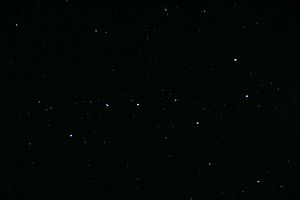Ursa Major Group

|
|
| The Big Dipper forms the core of the Ursa Major group | |
| AladinLite | |
| Constellation | Big Bear |
|
Position equinox : J2000.0 |
|
|---|---|
| Right ascension | 12 h 03 m |
| declination | + 58 ° 0 ′ |
| Appearance
|
|
| Brightness (visual) | 0.4 mag |
| Angular expansion | 20 ° |
| Brightest star | ε UMa 1.77 m mag |
| Physical data
|
|
| distance | 76 ly |
| Age | 700 million years |
| history | |
| Discovery time | prehistoric |
| Catalog names | |
| Cr 285 • | |
The Ursa Major Group, or Bears Group, is the largest and brightest open star cluster in the night sky. It consists of almost all bright stars of the constellation Great Bear and contains, apart from Dubhe (α UMa) and Benetnasch (η UMa), all the stars of the Big Dipper and other stars in its vicinity.
The extent of the group is about 20 °, with an average distance of about 75 light years, so about 30 light years. Its brightest star is Alioth (ε UMa) with a brightness of 1.77 mag , the total brightness of the cluster is (depending on the definition) at least 0.4 mag.
The cluster's eye-catching stars have been well known as asterism for millennia. Like other star clusters that have a large apparent diameter due to their proximity (e.g. the Hyades and the hair of the Berenike ), it was not included in the standard Messier , NGC or IC catalogs . It was not until Per Collinder that it was included in his catalog of open star clusters under the name Collinder 285 in 1931 .
Movement pile "Bärenstrom"
The Ursa Major group is also a so-called movement heap , i. This means that the stars have a similar proper motion of about 14 km / s with a vertex (target point) at the constellation Sagittarius , relative to the sun it is about 29 km / s. Through this parallel motion, over 150 other stars that appear farther away in the sky have also been identified as part of this group; the brightest of them are Sirius (α CMa), Menkalinan (β Aur), Gemma (α CrB), Delta Aquarii (δ Aqr, Skat) and Beta Serpentis (β Ser). To distinguish it from the constellation of the bear, the group of all these physically related stars is also called the Ursa Major Stream or the Bear Stream , and the Ursa Major Group forms the center of this stream as its densest part.
Our solar system is located on the edge of the Ursa Major Current, which can be seen from the fact that Sirius and Skat are almost diametrically opposed to the Big Dipper in the night sky (130–140 °); however, it moves in a different direction and is therefore not part of the current.
The solar system is about ten times older than the Ursa Major Current, which used to be an open star cluster and only drifted towards the solar system about 50 million years ago.
Group members
Core Stars (Big Dipper and Surroundings):
- 37 Ursae Maioris
- Merak (β Ursae Maioris)
- Phekda (γ Ursae Maioris)
- Megrez (δ Ursae Maioris)
- HD 109011
- HD 109647
- HD 110463
- Alioth (ε Ursae Maioris)
- 78 Ursae Maioris
- Gliese 503.2 (HD 115043)
- Mizar (ζ Ursae Maioris)
- Alkor (80 Ursae Maioris)
Other power stars (alphabetically according to constellations):
- Skat ( δ Aquarii )
- Menkalinan (β Aurigae)
- ζ Bootis
- 18 bootis
- Sirius (α Canis Maioris), but unsure of the age of the star
- χ Ceti
- ζ Crateris
- 29 Comae Berenices
- Gemma (α Coronae Borealis)
- 59 Draconis
- 21 Leonis Minoris
- γ Leporis
- 16 lyre
- γ Microscopii
- χ¹ Orionis
- 89 pisces
- β serpentis
- τ serpentis
- ω serpentis
- 6 sextantis
- 66 Tauri
- ζ Trianguli Australe
- π¹ Ursae Maioris
- 41 Virginis
Sources and literature
- J. Bennett, M. Donahue, N. Schneider, M. Voith: Astronomie , ed. Harald Lesch, 5th edition (1170 pages), Pearson-Studienverlag, Munich-Boston-Harlow-Sydney-Madrid 2010
- H. Zimmermann, A. Weigert: Lexicon of Astronomy , Spectrum Akadem.Verlag, Heidelberg-Berlin.